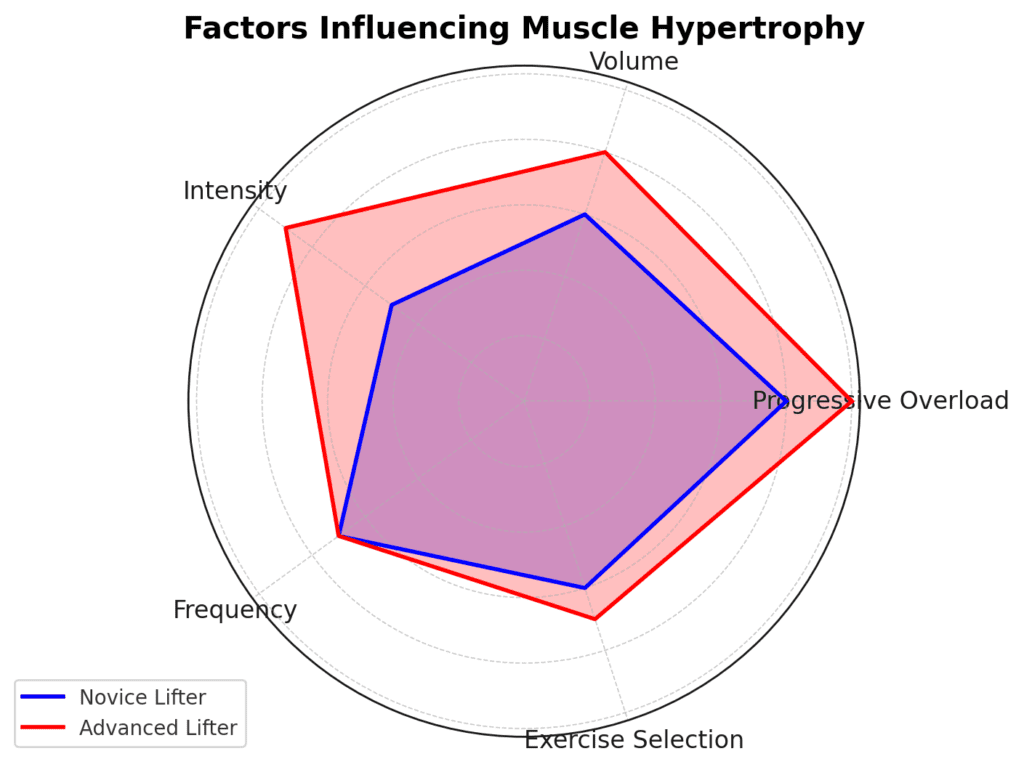Introduction to the Science and Development of Muscle Hypertrophy
In this article, we explore the science and development of muscle hypertrophy, revealing essential strategies to enhance your muscle growth.
Have you ever wondered why some people seem to make rapid progress in their muscle-building goals, while others struggle despite putting in similar effort? The answer often lies in the science and development of muscle hypertrophy. Imagine a person who spends hours lifting weights but sees minimal growth, while another individual seems to grow bigger just by looking at a dumbbell. The difference isn’t just in their workout routines or diet; it’s rooted in the complex science behind how muscles grow and adapt.
Understanding the science and development of muscle hypertrophy is not just for bodybuilders or elite athletes; it’s essential for anyone who wants to improve their fitness and strength. Muscle hypertrophy, the process by which muscle fibers increase in size, is a fundamental concept in fitness that directly impacts how effectively you can build muscle. Whether you’re a casual gym-goer or a serious lifter, understanding this process can lead to more informed decisions about your training and nutrition.

The purpose of this article is to delve deep into the science and development of muscle hypertrophy. We will explore how muscles grow, the various factors that influence this growth, and practical strategies you can use to maximize your muscle-building potential. By the end of this piece, you’ll have a clearer understanding of what happens at the cellular level when you train, and how you can leverage this knowledge to enhance your workouts and overall fitness.
Science and Development of Muscle Hypertrophy: The Basics of Muscle Hypertrophy
At its core, muscle hypertrophy involves the increase in the size of muscle fibers. This process is primarily driven by resistance training, where muscles are subjected to stress and strain, leading to their growth. The science and development of muscle hypertrophy can be broken down into several key concepts: muscle tension, muscle damage, and metabolic stress.
Subscribe And Get Our Free E-Book:Unlocking The Power Of Nutrition-Supplements, Substitutes, and Superfoods!
Muscle Tension and The Science and Development of Muscle Hypertrophy
When you lift weights or perform resistance exercises, your muscles generate force to overcome the resistance. This force generation creates tension within the muscle fibers. The greater the tension, the more the muscle is stimulated to grow. Progressive overload, which involves gradually increasing the weight or resistance in your workouts, is crucial for consistently challenging your muscles and promoting hypertrophy.
Muscle Damage
Another critical factor in the science and development of muscle hypertrophy is muscle damage. During intense resistance training, tiny tears occur in the muscle fibers. This muscle damage is a normal part of the training process and is necessary for growth. The repair process involves the body rebuilding the damaged fibers, making them stronger and larger than before. This adaptation helps you handle more significant loads in future workouts, contributing to overall muscle growth.
Metabolic Stress and The Science and Development of Muscle Hypertrophy
Metabolic stress refers to the accumulation of metabolic byproducts, such as lactate, during intense exercise. This stress can lead to an environment that promotes muscle growth. Exercises that cause high levels of metabolic stress often involve high repetitions and shorter rest periods. This type of training can increase the production of growth factors and hormones that support muscle hypertrophy.
Types of Hypertrophy
Muscle hypertrophy can be categorized into two main types: myofibrillar and sarcoplasmic hypertrophy. Understanding these types is part of the science and development of muscle hypertrophy.
Myofibrillar Hypertrophy
Myofibrillar hypertrophy focuses on increasing the size and number of myofibrils, the contractile units within muscle fibers. This type of hypertrophy is associated with increased muscle strength and density. Training that emphasizes lower repetitions with heavier weights typically promotes myofibrillar hypertrophy.
Sarcoplasmic Hypertrophy
Sarcoplasmic hypertrophy involves an increase in the volume of the sarcoplasm, the non-contractile component of muscle cells. This type of hypertrophy is linked to improvements in muscular endurance. Higher-repetition training with moderate weights tends to encourage sarcoplasmic hypertrophy, which can enhance the muscle’s capacity to store and use energy.
Chart: Comparison of Myofibrillar vs. Sarcoplasmic Hypertrophy
| Aspect | Myofibrillar Hypertrophy | Sarcoplasmic Hypertrophy |
|---|---|---|
| Focus | Growth of myofibrils (contractile proteins) | Increase in sarcoplasm (fluid in muscle cells) |
| Primary Goal | Strength and power | Muscular endurance and size (“muscle pump”) |
| Training Style | Low reps, high weight (e.g., 4-6 reps) | High reps, moderate weight (e.g., 8-15 reps) |
| Resulting Muscle Appearance | Dense, hard muscles | Fuller, larger muscles |
| Muscle Fiber Type Targeted | Type II (fast-twitch) | Type I (slow-twitch) and Type II |
| Examples of Exercises | Heavy deadlifts, squats, bench press | High-rep squats, curls, leg press |
| Adaptation Period | Longer to notice size increase, but strength builds quickly | Quicker size increase, endurance improves over time |
| Energy System Used | Primarily ATP-PC (adenosine triphosphate-phosphocreatine) | Primarily anaerobic glycolysis |
| Ideal for | Athletes focusing on powerlifting, Olympic lifting, sports requiring explosive power | Bodybuilders, fitness enthusiasts looking for muscle size and endurance |
Additional Insight:
- Combination Approach: Most athletes and bodybuilders aim to incorporate both types of hypertrophy in their training routines to develop well-rounded muscle strength, size, and endurance.
Factors Influencing Muscle Hypertrophy
Several factors affect how effectively you can achieve muscle hypertrophy. These include:
Genetics
Your genetic makeup plays a significant role in how your muscles respond to training. Some people naturally have a higher potential for muscle growth due to their genetic predisposition.
Nutrition
A well-balanced diet rich in protein, carbohydrates, and healthy fats is crucial for supporting muscle growth. Protein provides the essential amino acids needed for muscle repair and growth, while carbohydrates supply the energy required for intense workouts. Adequate caloric intake ensures that your body has the resources to build new muscle tissue.
Rest and Recovery
Muscle growth occurs not just during exercise but also during rest. Ensuring that you get sufficient sleep and allowing your muscles time to recover between workouts are critical for maximizing hypertrophy. Overtraining can hinder muscle growth and increase the risk of injury.
Training Variables
The design of your workout program, including the choice of exercises, sets, repetitions, and rest intervals, significantly impacts muscle hypertrophy. Varying these variables can help prevent plateaus and continue stimulating muscle growth.

Practical Applications of The Science And Development of Muscle Hyperthrophy
To apply the principles of the science and development of muscle hypertrophy effectively, consider these practical tips:
- Incorporate Progressive Overload: Gradually increase the weight or resistance in your exercises to continuously challenge your muscles.
- Focus on Compound Movements: Exercises like squats, deadlifts, and bench presses engage multiple muscle groups and are highly effective for promoting hypertrophy.
- Vary Your Repetitions and Rest Periods: Combining low-rep, high-weight sets with high-rep, moderate-weight sets can stimulate different types of hypertrophy.
- Prioritize Recovery: Ensure you get adequate sleep and rest between workouts to support muscle repair and growth.
Understanding the science and development of muscle hypertrophy provides valuable insights into how your muscles grow and adapt to resistance training. By applying this knowledge to your training and nutrition strategies, you can optimize your efforts and achieve your muscle-building goals more effectively. Stay tuned as we continue to explore more aspects of muscle hypertrophy in the next part of our series.
Understanding Muscle Hypertrophy
To effectively navigate the science and development of muscle hypertrophy, it’s essential to have a clear understanding of what muscle hypertrophy is, its different types, and how various muscle fibers contribute to this process. Let’s break this down into manageable parts.
Science Of Growth, Hyperthrophy and Building Muscle Video
Definition of Muscle Hypertrophy
Muscle hypertrophy refers to the increase in the size of muscle fibers. This growth occurs primarily as a response to resistance training, where muscles are subjected to stress and strain. There are two primary types of hypertrophy: myofibrillar hypertrophy and sarcoplasmic hypertrophy.
Myofibrillar Hypertrophy focuses on increasing the size and number of myofibrils, the contractile units within muscle fibers. This type of hypertrophy enhances muscle strength and density. Sarcoplasmic Hypertrophy, on the other hand, increases the volume of sarcoplasm, the non-contractile component of muscle cells. This type improves muscular endurance by increasing the muscle’s capacity to store and use energy.
Types of Hypertrophy
Understanding the science and development of muscle hypertrophy involves distinguishing between transient and chronic hypertrophy.
Transient Hypertrophy is the temporary increase in muscle size that occurs immediately after a workout. This type of hypertrophy is often referred to as “muscle pump” and is caused by the accumulation of blood and other fluids in the muscle tissues during exercise. While transient hypertrophy provides a quick boost in muscle size, it does not contribute significantly to long-term muscle growth.
Chronic Hypertrophy is the more permanent increase in muscle size that results from consistent resistance training over time. This type of hypertrophy occurs due to the adaptation of muscle fibers to repeated bouts of exercise, leading to actual growth in muscle fiber size and an increase in muscle mass. Chronic hypertrophy is the primary goal of most resistance training programs and is crucial for long-term muscle development.
Role of Muscle Fiber Types
To fully grasp the science and development of muscle hypertrophy, it’s also important to understand how different muscle fiber types contribute to muscle growth. Human muscles contain two main types of muscle fibers: Type I and Type II.
Type I Muscle Fibers, also known as slow-twitch fibers, are more resistant to fatigue and are primarily used for endurance activities. These fibers have a high density of mitochondria and a rich blood supply, which supports their ability to sustain prolonged exercise. While Type I fibers do contribute to muscle hypertrophy, they are less prone to significant growth compared to Type II fibers due to their inherent endurance characteristics.
Type II Muscle Fibers, or fast-twitch fibers, are more suited for explosive and high-intensity activities. These fibers generate more force and have a greater potential for hypertrophy compared to Type I fibers. Type II fibers are responsible for rapid and powerful contractions, making them a key player in activities like weightlifting and sprinting. The recruitment of Type II fibers during resistance training stimulates greater muscle growth and contributes significantly to the development of muscle mass.
When training for hypertrophy, focusing on exercises that engage Type II fibers, such as heavy lifting and explosive movements, can lead to more substantial gains in muscle size and strength. However, a well-rounded program that includes both endurance and strength components will ensure balanced development and overall fitness.
The science and development of muscle hypertrophy encompass understanding muscle hypertrophy itself, recognizing the differences between transient and chronic hypertrophy, and knowing how various muscle fiber types contribute to muscle growth. By incorporating these insights into your training regimen, you can optimize your approach to building muscle and achieve your fitness goals more effectively.

The Science Behind Muscle Growth
When delving into the science and development of muscle hypertrophy, it’s essential to understand the intricate mechanisms that underpin muscle growth. This involves exploring muscle fiber recruitment, the mechanisms of hypertrophy, and the cellular responses that contribute to building muscle. Let’s examine these elements in detail.
Muscle Fiber Recruitment
Understanding the science and development of muscle hypertrophy begins with how muscles are recruited during exercise. Motor units, which consist of a motor neuron and the muscle fibers it controls, play a crucial role in muscle contraction. When you engage in resistance training, your body recruits motor units to generate the force needed for the activity.
Motor Units are activated in a specific order based on the intensity of the exercise. Low-intensity activities primarily engage smaller motor units that control Type I muscle fibers. As the intensity increases, larger motor units that control Type II muscle fibers are recruited. This recruitment pattern ensures that your muscles can produce the necessary force to complete the exercise.
For effective muscle hypertrophy, it’s important to engage Type II muscle fibers through higher-intensity exercises. These fibers have a greater capacity for growth and are stimulated more significantly during heavy lifting or explosive movements.
Mechanisms of Hypertrophy
Several key mechanisms contribute to the science and development of muscle hypertrophy. Understanding these mechanisms can help optimize your training regimen for better muscle growth.
Mechanical Tension
Mechanical tension is one of the primary drivers of muscle hypertrophy. When you lift heavy weights, the mechanical tension placed on muscle fibers triggers a series of biological processes that lead to muscle growth. High-intensity resistance training creates substantial tension in the muscle, stimulating the synthesis of proteins needed to repair and strengthen the muscle fibers.
Lifting heavy weights causes micro-tears in muscle fibers, which are then repaired through a process that increases muscle mass. This mechanical tension is crucial for promoting myofibrillar hypertrophy, where the size and number of myofibrils within muscle fibers increase, leading to greater muscle strength and density.
Metabolic Stress
Metabolic stress is another important factor in the science and development of muscle hypertrophy. This type of stress occurs when intense exercise leads to the accumulation of metabolic byproducts such as lactate, hydrogen ions, and inorganic phosphates within the muscle. These metabolites contribute to a growth-promoting environment by increasing cellular swelling and stimulating the release of anabolic hormones.
Exercises that induce significant metabolic stress often involve higher repetitions and shorter rest periods. This approach can enhance sarcoplasmic hypertrophy, increasing the muscle’s ability to store and utilize energy. The build-up of metabolites not only contributes to muscle growth but also improves muscular endurance and performance.
Muscle Damage
Muscle damage is a critical component in the science and development of muscle hypertrophy. During resistance training, particularly with eccentric contractions (where the muscle lengthens under tension), micro-tears occur in the muscle fibers. This damage is a natural part of the training process and is essential for muscle growth.
The repair process involves the activation of satellite cells, which are specialized cells responsible for repairing and regenerating damaged muscle fibers. As these cells repair the micro-tears, they contribute to muscle growth and adaptation. This process helps the muscle become stronger and more resilient to future stress.
Cellular Responses
The cellular responses involved in the science and development of muscle hypertrophy are crucial for understanding how muscles grow and adapt. Key cellular responses include the role of satellite cells, the balance between protein synthesis and breakdown, and hormonal influences.
Satellite Cells
Satellite cells are integral to muscle repair and growth. These cells are located on the surface of muscle fibers and become activated in response to muscle damage. Once activated, satellite cells proliferate and fuse with existing muscle fibers, contributing to muscle repair and hypertrophy. This process not only helps in the recovery of damaged muscle but also adds new muscle tissue, leading to increased muscle mass.
Protein Synthesis vs. Breakdown
A crucial aspect of muscle growth involves the balance between muscle protein synthesis (MPS) and muscle protein breakdown (MPB). MPS refers to the process of building new muscle proteins, while MPB involves the degradation of existing muscle proteins.
To promote muscle hypertrophy, MPS needs to exceed MPB. Resistance training stimulates MPS by triggering the signaling pathways responsible for muscle growth. Adequate protein intake and recovery strategies also play a significant role in optimizing this balance. Ensuring that your diet provides enough protein and that you allow sufficient time for rest and recovery can help maximize muscle protein synthesis and support overall muscle growth.

Hormonal Influences
Hormones play a significant role in the science and development of muscle hypertrophy. Key hormones involved in muscle growth include testosterone, growth hormone, and insulin-like growth factor (IGF-1).
Testosterone is an anabolic hormone that enhances muscle protein synthesis and promotes muscle growth. Higher levels of testosterone are associated with increased muscle mass and strength.
Growth Hormone supports muscle growth by stimulating the production of IGF-1 and promoting the release of fatty acids from adipose tissue. This hormone helps in the repair and regeneration of muscle fibers, contributing to overall muscle hypertrophy.
Insulin-like Growth Factor (IGF-1) is another crucial hormone that supports muscle growth. IGF-1 promotes the proliferation and differentiation of satellite cells, enhancing muscle repair and growth. It also plays a role in regulating protein metabolism and reducing muscle protein breakdown.
The science and development of muscle hypertrophy involves a detailed understanding of muscle fiber recruitment, the mechanisms of hypertrophy, and cellular responses. By comprehending how mechanical tension, metabolic stress, and muscle damage contribute to muscle growth, as well as the role of satellite cells, protein synthesis, and key hormones, you can better tailor your training and nutrition strategies to optimize muscle hypertrophy.
Training Principles in the Science and Development of Muscle Hypertrophy
In the science and development of muscle hypertrophy, the application of effective training principles is crucial for achieving optimal muscle growth. By understanding and applying principles such as progressive overload, volume and intensity, frequency and recovery, and exercise selection, you can tailor your workouts to maximize muscle hypertrophy. Let’s delve into these key training principles.
Progressive Overload in The Science And Development Of Muscle Hypertrophy
Progressive overload is a foundational principle in the science and development of muscle hypertrophy. It involves gradually increasing the stress placed on your muscles over time. This can be achieved by adding more weight, increasing the number of repetitions, or extending the duration of your workouts. The goal is to continually challenge your muscles to adapt to higher levels of stress, which stimulates growth.
When you consistently apply progressive overload, your muscles are forced to adapt by becoming stronger and larger. For instance, if you regularly lift a certain weight and do not increase it, your muscles will eventually become accustomed to the stress, leading to stagnation in growth. By progressively increasing the load, you ensure that your muscles are consistently challenged, leading to continuous improvement and hypertrophy.
Volume and Intensity in The Science And Development Of Muscle Hypertrophy
The volume and intensity of your workouts play significant roles in the science and development of muscle hypertrophy.
Volume refers to the total amount of work performed in a workout, typically measured by the number of sets and repetitions. Higher volume training, which involves performing more sets and reps, can stimulate muscle growth by increasing the total workload on the muscles. This approach often leads to greater metabolic stress and muscle damage, both of which are key drivers of hypertrophy.
Intensity relates to the amount of weight lifted relative to your maximum strength. Training with higher intensity, such as lifting heavier weights, stimulates muscle fibers more effectively and promotes greater hypertrophy. It’s important to balance intensity with volume to avoid overtraining and to ensure that muscles are adequately stimulated for growth.
Frequency and Recovery
Frequency and recovery are critical components in the science and development of muscle hypertrophy.
Training Frequency refers to how often you work out a particular muscle group. While training each muscle group multiple times a week can be beneficial for muscle growth, it’s essential to allow adequate time for recovery. A common approach is to train each muscle group 2 to 3 times per week, ensuring that there is enough time between sessions for muscles to recover and repair.
Recovery is equally important for hypertrophy. Muscle growth occurs during the recovery phase when the body repairs and rebuilds muscle fibers. Without sufficient rest, the muscles do not have the opportunity to fully recover, which can impede growth and lead to overtraining. Adequate sleep, proper nutrition, and rest days are essential to support the muscle repair process and optimize hypertrophy.
Exercise Selection
Choosing the right exercises is a key aspect of the science and development of muscle hypertrophy. Understanding the roles of compound and isolation exercises can help you design an effective training program.
Compound Exercises involve multiple joints and muscle groups. Examples include squats, deadlifts, bench presses, and pull-ups. These exercises are highly effective for stimulating overall muscle growth because they engage a larger number of muscle fibers and allow for the use of heavier weights. Compound exercises also enhance functional strength and can lead to significant improvements in muscle mass.
Isolation Exercises, on the other hand, target a single joint and muscle group. Examples include bicep curls, tricep extensions, and leg curls. While isolation exercises are not as effective for overall muscle growth as compound exercises, they are valuable for targeting specific muscles and enhancing detail and definition. Incorporating isolation exercises into your routine can help address muscle imbalances and ensure balanced development.
The science and development of muscle hypertrophy are closely linked to the application of key training principles. Progressive overload ensures that your muscles are continually challenged, leading to growth. Volume and intensity contribute to the effectiveness of your workouts by increasing the overall stress on your muscles. Frequency and recovery are crucial for allowing your muscles to repair and grow. Finally, exercise selection helps you target both major muscle groups and specific muscles to achieve comprehensive hypertrophy. By integrating these principles into your training regimen, you can optimize your muscle-building efforts and achieve your desired results.
Nutrition for Muscle Growth
In the science and development of muscle hypertrophy, nutrition plays a pivotal role in optimizing muscle growth and recovery. To effectively support muscle development, understanding your macronutrient requirements, meal timing, and hydration needs is essential. Here’s a detailed look at how nutrition can enhance your muscle-building efforts.

Macronutrient Requirements
Protein is fundamental for muscle repair and growth. When you engage in resistance training, your muscle fibers undergo stress and minor damage. Protein provides the essential amino acids required for repairing these damaged fibers and building new muscle tissue. For effective hypertrophy, it is generally recommended to consume approximately 1.6 to 2.2 grams of protein per kilogram of body weight per day. High-quality protein sources include lean meats such as chicken, beef, and fish, as well as plant-based options like tofu, legumes, and quinoa. Incorporating a variety of protein sources can ensure you receive all the necessary amino acids to support muscle growth.
Carbohydrates play a crucial role in fueling your workouts and aiding recovery. During intense exercise, your body relies on glycogen, which is stored in your muscles and liver, as a primary energy source. Consuming adequate carbohydrates before and after your workouts helps replenish glycogen stores, maintain energy levels, and support optimal performance. Aim for complex carbohydrates such as whole grains, fruits, and vegetables, which provide sustained energy and essential nutrients. Carbohydrate intake should be adjusted based on your training intensity and volume, with higher amounts needed during periods of intense training or increased physical activity.
Fats are another important component of your diet, contributing to overall health and hormone production. Healthy fats, such as those found in avocados, nuts, seeds, and fatty fish, support hormone balance, including the production of anabolic hormones like testosterone and growth hormone. These hormones are crucial for muscle growth and repair. Additionally, fats help with the absorption of fat-soluble vitamins (A, D, E, and K) and provide long-lasting energy. While fats should be included in your diet, it’s important to balance them with proteins and carbohydrates to meet your overall energy and nutritional needs.
Meal Timing and Frequency
The timing and frequency of your meals can significantly impact the science and development of muscle hypertrophy. Nutrient timing refers to the strategic consumption of nutrients around your workouts to maximize performance and recovery.
Pre-Workout Nutrition: Eating a balanced meal that includes protein and carbohydrates 1 to 2 hours before your workout can provide the necessary energy and amino acids to support muscle performance and growth. A combination of protein and carbs ensures that your muscles are fueled for the workout ahead and helps maintain energy levels throughout your training session.
Post-Workout Nutrition: Consuming a meal or snack rich in protein and carbohydrates within 30 to 60 minutes after your workout is essential for optimizing recovery. This post-workout window is crucial for replenishing glycogen stores, repairing muscle damage, and stimulating muscle protein synthesis. Examples of effective post-workout foods include a protein shake with a banana or a meal containing chicken breast with quinoa and vegetables.
Meal Frequency: Eating smaller, balanced meals throughout the day can help maintain stable energy levels and support continuous muscle repair and growth. Aim for 4 to 6 meals per day, each including a source of protein, carbohydrates, and healthy fats. This approach ensures that your body receives a steady supply of nutrients to support muscle hypertrophy and overall health.
Hydration
Staying well-hydrated is a fundamental aspect of the science and development of muscle hypertrophy. Proper hydration is essential for maintaining optimal performance during workouts and facilitating recovery. Water plays a critical role in various bodily functions, including nutrient transport, temperature regulation, and muscle function.
During Exercise: Adequate hydration helps maintain blood volume and electrolyte balance, which is crucial for sustaining exercise performance and preventing dehydration-related fatigue. Drinking water before, during, and after your workouts helps ensure that you remain hydrated and can perform at your best.
Post-Exercise Recovery: After intense physical activity, rehydrating with water or an electrolyte-rich drink can help restore fluid balance and support muscle recovery. Dehydration can impair muscle function and prolong recovery time, so it’s important to drink sufficient fluids throughout the day to support overall hydration and muscle repair.
The science and development of muscle hypertrophy are closely linked to proper nutrition. Meeting your macronutrient needs—protein for muscle repair, carbohydrates for energy, and fats for hormone production—is crucial for optimal muscle growth. Strategic meal timing around workouts and maintaining adequate hydration further support muscle development and recovery. By integrating these nutritional principles into your routine, you can enhance your muscle-building efforts and achieve your fitness goals more effectively.
Science and Development of Muscle Hypertrophy Chart: Factors Influencing Muscle Hypertrophy:

Practical Tips and Strategies for Effective Muscle Growth
When applying the science and development of muscle hypertrophy, designing a personalized workout plan is essential for achieving your muscle growth goals. Rather than adhering to a one-size-fits-all approach, it’s crucial to understand how to tailor your workouts to your individual needs. This involves creating an effective hypertrophy program, tracking your progress, and avoiding common pitfalls. Here’s how you can develop a workout routine that aligns with the principles of muscle hypertrophy.

Creating a Personalized Hypertrophy Program
A successful hypertrophy program should be customized based on your specific goals, experience level, and individual preferences. Here’s a guide to help you build a workout plan that effectively promotes muscle growth:
1. Understand Exercise Types
- Compound Exercises: These involve multiple joints and muscle groups. Examples include squats, deadlifts, bench presses, and pull-ups. Compound exercises are effective for overall muscle development and should form the cornerstone of your program. They allow you to lift heavier weights and engage more muscle fibers, which is crucial for stimulating hypertrophy.
- Isolation Exercises: These target single joints and specific muscle groups, such as bicep curls, tricep extensions, and leg curls. While isolation exercises are less effective for overall mass, they are valuable for focusing on particular muscles and improving detail. They should complement compound movements in your routine.
2. Determine Sets and Reps
- Reps (Repetitions): Reps refer to the number of times you perform a specific exercise in one set. For hypertrophy, the typical rep range is 6-12 repetitions. This range is effective for maximizing muscle growth while balancing intensity and volume.
- Sets: Sets are the number of times you repeat a given exercise. To promote muscle hypertrophy, aim for 3-4 sets per exercise. The number of sets can vary depending on the exercise and your overall workout volume.
- Progressive Overload: Gradually increase the weight, reps, or sets over time to continue challenging your muscles and stimulate growth. If you find that you can easily complete your sets and reps, it’s a sign that you need to increase the intensity.
3. Frequency of Workouts
- Training Frequency: The frequency with which you train each muscle group can influence hypertrophy. A common approach is to train each muscle group 2-3 times per week. This allows you to balance intensity and recovery, promoting muscle growth while preventing overtraining.
- Split Training vs. Full-Body Workouts: Depending on your preferences and goals, you can choose between split training (focusing on different muscle groups on different days) or full-body workouts (engaging all major muscle groups in each session). Both approaches can be effective for muscle growth, but your choice should align with your schedule and recovery needs.
4. Incorporate Various Training Techniques
- Drop Sets: This technique involves performing an exercise until failure, then reducing the weight and continuing for additional reps. Drop sets can increase muscle fatigue and promote hypertrophy.
- Supersets: Performing two exercises back-to-back with no rest in between. Supersets can enhance training efficiency and increase muscle endurance.
- Rest-Pause Training: Involves taking short rest periods during a set to perform additional reps. This method can help push your muscles beyond their normal limits and stimulate growth.
Tracking Your Progress
To gauge the effectiveness of your hypertrophy program and make necessary adjustments, tracking progress is essential:
1. Monitor Strength Gains
Keep a log of the weights you lift, the number of sets and reps you complete, and any improvements over time. Tracking these metrics allows you to identify trends and ensure you’re progressively overloading your muscles.
2. Measure Muscle Size
Use a tape measure to periodically assess the size of key muscle groups. Tracking changes in muscle circumference can provide tangible evidence of muscle growth and help you adjust your training accordingly.
3. Assess Body Composition
Regularly check your body composition to monitor changes in muscle mass and body fat percentage. Tools like body fat scales or professional assessments can offer insights into how well your training and nutrition strategies are working.
4. Take Progress Photos
Photographing your physique under consistent lighting and conditions can help you visually track changes in muscle size and definition. Comparing photos over time provides a clear picture of your overall progress.
Avoiding Common Mistakes
Despite following a well-structured program, certain mistakes can hinder muscle growth. Here’s how to avoid them:
1. Neglecting Progressive Overload
Failure to increase the intensity of your workouts can lead to plateaus. Continuously challenge your muscles by gradually increasing weights, reps, or sets.
2. Poor Nutrition
Inadequate protein intake, insufficient carbohydrates, or imbalanced fat consumption can impede muscle growth. Ensure you meet your macronutrient needs to support muscle repair and energy requirements.
3. Inconsistent Training
Skipping workouts or not following a consistent routine can disrupt progress. Stick to your program and ensure regular, balanced training sessions.
4. Ignoring Recovery
Overtraining without sufficient recovery can hinder muscle growth and increase injury risk. Prioritize rest, sleep, and recovery days to support muscle repair and overall health.
5. Incorrect Form
Performing exercises with improper form can reduce effectiveness and lead to injury. Focus on correct technique and consider seeking guidance from a trainer if needed.
6. Skipping Warm-Ups and Cool-Downs
Neglecting warm-ups and cool-downs can affect performance and recovery. Always include these components to prepare your muscles and aid in post-workout recovery.
The science and development of muscle hypertrophy involves creating a personalized workout plan that incorporates compound and isolation exercises, determining appropriate sets and reps, and choosing the right training frequency. Tracking progress through strength gains, muscle measurements, and body composition, along with avoiding common mistakes, will help you optimize your muscle-building efforts. By understanding and applying these practical tips and strategies, you can effectively work towards achieving your muscle growth goals.
Supplements and Their Role in Muscle Growth
In the science and development of muscle hypertrophy, supplements often play a supporting role in enhancing muscle growth, improving performance, and aiding recovery. Understanding the function and effectiveness of various supplements can help you make informed decisions about their use. Here’s a detailed look at some popular supplements, their scientific backing, and how to use them safely.

Popular Supplements
Creatine is one of the most researched and widely used supplements in the fitness community. It is known for its ability to enhance strength, increase muscle mass, and improve performance during high-intensity exercise. Creatine increases the availability of ATP (adenosine triphosphate), which is the primary source of energy for muscle contractions. This leads to improved performance in activities such as weightlifting and sprinting.
Branched-Chain Amino Acids (BCAAs), which include leucine, isoleucine, and valine, are popular among athletes and bodybuilders. BCAAs are essential amino acids that the body cannot produce on its own, thus they must be obtained from diet or supplements. They play a crucial role in muscle protein synthesis and can help reduce muscle soreness and fatigue. They are particularly useful during prolonged or intense exercise sessions.
Protein Powders are a convenient way to ensure adequate protein intake, which is crucial for muscle repair and growth. Whey protein, casein protein, and plant-based proteins like pea or soy protein are common types. Whey protein is quickly absorbed, making it ideal for post-workout recovery, while casein is digested slowly, providing a steady release of amino acids. Plant-based proteins are a good option for those who prefer a vegan or vegetarian diet.
Evidence-Based Use
The effectiveness of these supplements is supported by substantial scientific research:
Creatine: Numerous studies have shown that creatine supplementation can significantly improve muscle strength, power, and mass. Research indicates that creatine helps increase phosphocreatine stores in the muscles, which can enhance performance in high-intensity, short-duration activities. The loading phase, typically involving 20 grams per day for 5-7 days, followed by a maintenance dose of 3-5 grams per day, is a common approach to maximizing its benefits.
BCAAs: Research on BCAAs has demonstrated that they can help stimulate muscle protein synthesis and reduce muscle breakdown during exercise. They may also aid in reducing exercise-induced muscle soreness. However, it is worth noting that if you consume adequate protein from your diet, additional BCAA supplementation may have limited additional benefits.
Protein Powders: Protein supplementation has been extensively studied, and evidence supports its effectiveness in promoting muscle growth and repair. Protein powders are a convenient method to meet daily protein needs, especially for individuals who struggle to get sufficient protein from whole foods alone. Studies have shown that protein intake, particularly post-workout, can enhance muscle recovery and support hypertrophy.
Safety and Efficacy
When considering supplements for the science and development of muscle hypertrophy, it is essential to choose products that are safe and effective. Here are some guidelines for using supplements safely:
Choose Quality Products: Select supplements from reputable brands that undergo third-party testing for purity and potency. Look for certifications from organizations such as NSF International or Informed-Sport to ensure the product is free from contaminants and accurately labeled.
Follow Recommended Dosages: Adhere to the recommended dosages provided by the manufacturer or as advised by a healthcare professional. Excessive use of supplements does not necessarily enhance results and can lead to adverse effects.
Consult a Healthcare Professional: Before starting any new supplement regimen, especially if you have underlying health conditions or are taking other medications, consult with a healthcare provider. They can help determine if a supplement is appropriate for you and advise on proper dosages.
Be Cautious with Unproven Supplements: Avoid supplements that make exaggerated claims or promise quick fixes. Many products on the market lack scientific evidence to support their effectiveness. Research and verify the claims of any supplement before use.
Steroids and Their Impact
In the context of the science and development of muscle hypertrophy, it’s important to address anabolic steroids, which are sometimes used to enhance muscle growth. However, their use is controversial and comes with significant health risks.
Anabolic Steroids are synthetic derivatives of testosterone designed to increase muscle mass and improve athletic performance. While they can lead to substantial gains in muscle size and strength, their use is associated with numerous side effects and health risks. These include hormonal imbalances, liver damage, cardiovascular issues, and psychiatric effects such as aggression and mood swings.
Legal Status: The use of anabolic steroids without a prescription is illegal in many countries. They are classified as controlled substances due to their potential for abuse and harmful health effects. In the sports and fitness communities, the use of anabolic steroids is often banned and can result in severe penalties, including disqualification from competition and legal consequences.
Health Risks: Beyond the legal issues, the health risks associated with anabolic steroid use are significant. Long-term use can lead to serious health problems, including heart disease, liver damage, reproductive issues, and psychiatric disorders. It is crucial to consider these risks and explore safer, natural methods to achieve muscle growth.
The science and development of muscle hypertrophy involve understanding the role of various supplements, evaluating their scientific backing, and using them safely. Popular supplements like creatine, BCAAs, and protein powders have substantial research supporting their benefits for muscle growth. However, it’s important to approach supplement use with caution, prioritize quality and safety, and consult healthcare professionals when necessary. Additionally, while anabolic steroids can produce significant muscle gains, their use carries considerable risks and is generally discouraged due to legal and health concerns. By making informed choices, you can enhance your muscle-building efforts while safeguarding your overall health.
Final Thoughts on the Science and Development of Muscle Hypertrophy
As we conclude our exploration of the science and development of muscle hypertrophy, it’s essential to reflect on the key concepts we’ve covered and understand their significance in the context of muscle growth. By synthesizing these insights, you can better apply the principles to your fitness journey and continue evolving with the latest advancements in the field.

Recap of Key Points
The journey through the science and development of muscle hypertrophy has offered a comprehensive look into how muscles grow and how you can optimize this process. We began by understanding the fundamental concepts of muscle hypertrophy, including the definitions of myofibrillar and sarcoplasmic hypertrophy, and the differences between transient and chronic hypertrophy. This foundational knowledge set the stage for grasping the critical aspects of muscle fiber recruitment and the mechanisms driving hypertrophy, such as mechanical tension, metabolic stress, and muscle damage.
Training Principles were then explored, emphasizing the importance of progressive overload, volume, intensity, frequency, and recovery. We discussed how these elements contribute to effective muscle growth and how to tailor your training regimen to achieve optimal results. By understanding the principles of progressive overload and adjusting your workout variables accordingly, you can continually challenge your muscles and foster growth.
In our examination of nutrition for muscle growth, we highlighted the role of macronutrients—protein, carbohydrates, and fats—in supporting muscle repair and overall health. Proper meal timing, nutrient intake, and hydration were also underscored as crucial components of a successful hypertrophy program. This section emphasized that while exercise is vital, nutrition and hydration are equally important for maximizing muscle growth and recovery.
The discussion then moved to supplements and their role, focusing on popular choices such as creatine, BCAAs, and protein powders. We examined the evidence supporting their use, emphasizing that while supplements can be beneficial, they should complement, not replace, a well-balanced diet. We also touched on the legal and health risks associated with anabolic steroids, reinforcing the importance of safe and legal practices.
Encouragement for Application
With a solid understanding of the science and development of muscle hypertrophy, it’s time to apply these principles to your personal fitness routine. Tailor your workout program to incorporate progressive overload, select appropriate exercises, and adjust training frequency to align with your goals. Balance your nutrition to support muscle repair and growth, and consider supplements only as a supplementary aid rather than a primary source of muscle-building benefits.
Stay informed about ongoing research and evolving methods in the field. The science of muscle hypertrophy is continually advancing, and new insights can offer additional strategies to enhance your training and nutrition practices. Keeping up with the latest studies and developments will enable you to refine your approach and make data-driven decisions that support your muscle growth goals.
In closing, the science and development of muscle hypertrophy is a multifaceted field that requires a comprehensive approach. By integrating effective training techniques, proper nutrition, and careful supplementation, you can create a robust framework for muscle growth. Applying these principles with consistency and dedication will not only help you achieve your desired results but also contribute to your overall health and fitness.
Remember, achieving muscle hypertrophy is a dynamic process that involves continuous learning and adaptation. Embrace the journey, stay informed, and remain committed to applying the principles discussed. Your efforts will pave the way for substantial progress and long-term success in your muscle-building endeavors.


